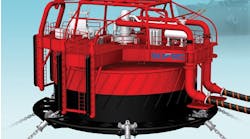Trials suggest harsh environment subsea trees are feasible
Tree component challenges manageable
Steve Fenton
ABB Vetco Gray
- Non-linear FEA stress plot of critical sections of tubing hanger. [17,134 bytes]
- Critical section through valve block, showing bore center spacing. [15,646 bytes]
- HT-MS tubing hanger seal alongside conventional (non-HP/HT) seal. [19,881 bytes]
The main outcome of the work done by ABB Vetco Gray to date shows that the subsea hardware development program is solidly founded on tried and proven equipment, but with an emphasis on extending the capabilities of metal sealing systems to promote in-service relaibility and low life cycle cost.
Initially, the main focus was on establishing the structural viability of a 5 1/8-in. by 2 1/16-in. dual bore tree system. This required extensive 3D finite element analysis (FEA) on the valve block and tubing hanger, in order to optimize critical sectional geometries, center spacing of the production and annulus bores, and bore offsets.
The result was a center spacing of 5.625-in., with a production bore offset from center of 1.595-in., enabling installation of up to 5 1/2-in. production tubing inside heavy wall 10 3/4-in. production casing. Account was also taken of the interface with the SCSSV, associated control lines, couplings and clamps, as well as suppliers of tubing plugs, to ensure accommodation of the necessary profiles, particularly in the case of a dog-leg on the annulus bore. The design of the valve block allows for cladding in the production bore, using alloy 625 for high corrosion resistance.
Test experience
Next, sizing of the completion riser tubulars and associated FEA on the riser connector were performed both to optimize the connector's fatigue life and to provide input into the dynamic riser analysis, which was carried out under North Sea Central Graben environmental conditions. This confirmed that acceptable operating envelopes and fatigue life could be accomplished with the system. The analysis was necessitated by the fact that the system has significantly higher stiffness than systems typically deployed to date, which tend to be 4 1/18-in. or 5 1/18-in., 5,000 or 10,000 psi wellhead pressure rated. The calculated weight of the riser is nominally 120 lbs/ft, compared with 80 lbs/ft for the corresponding 10,000 psi rated system.To maximize standardization benefits, the 18 3/4-in. HT-H4 connector developed initially for the standard 10,000 WP rated horizontal tree system was adopted. The additional capacity demanded by drilling stack-generated bending moments potentially provided the capability needed for a 15,000 psi rated conventional tree, with reduced bending moment requirements due to deployment via a dual bore completion riser.
The tree to wellhead connector's structural capacity was accordingly FEA verified in conjunction with physical pressure and bending tests which confirmed the connector's ability to withstand extreme bending moments. Testing was performed at 1.65 by 106 ft-lbs, with 15,000 psi simultaneously applied out to the VX gasket.
System sealing
System sealing elements were reviewed in order to establish a performance verification test program, consistent with the design specification of 15,000 psi WP at 35-400°F, as per API 17D test requirements. Further analysis was needed to establish probable temperature distribution in the system components while in production. This work was realized though analytical modeling, using both 1-dimensional (radial) heat transfer, in the case of the wellhead and flowline connectors, and 2-dimensional (radial and axial) transfer for valve actuators.The results indicate that hydraulic sealing systems on the seabed equipment will not be subjected to temperatures in excess of standard ratings (250°F) for such seals. This confirms the view that no specific verification testing is necessary for such items, particularly where these products are already qualified to a standard rating that exceeds the likely temperature range in situ.
Finally, critical sealing components, which would be subjected directly to wellhead pressure and/or temperature were tested at full rated 15,000 psi WP and over the rated temperature range of 35-400°F, in line with API 17D procedures. The items tested were as follows:
- Tubing hanger seal (HT-MS): This design is based on the seal developed for the horizontal tree tubing hanger, albeit smaller in nominal diameter. The seal is an all-metal, radially energized seal element, in preference to the traditional elastomer with metal end lips used for less severe service.
- Tubing hanger stab seals (U-seals): These newly developed designs required significant 2D non-linear (plastic) FEA to optimize seal leg geometry. The purpose was to achieve sufficient structural capacity while also providing the flexibility to initiate sealing without over-stressing due to initial radial fit and to promote sufficient pressure energization as pressure is applied, without imparting excessive bearing contact stress, in order to assure repeatability. Both 5 1/8-in. and 2 1/16-in. U-seals were tested successfully.
- EDP/LRP conduit seals (SSD): FEA was conducted on the standard 5 1/8-in. and 2 1/16-in. 10,000 WP-rated seals to evaluate whether these might be extended to HP/HT requirements without modification. Results were encouraging, and this was confirmed by successful completion of the testing on both sizes without having to modify either geometry or material selection.
- Actuated valve stem sealing packages:
Elastomer seals
Intervention riser stab seals were the only elastomeric seals to be put through qualification tests. The nature of this application (relatively frequent make and break out at the drill floor) is such that reliable and durable all-metal sealing is an impractical ambition offshore without significant pre-load at sealing interfaces, which would significantly impact the connector design.Use of elastomeric seals was further justified by the fact that this equipment will only be exposed to well conditions intermittently, during well clean-up and/or extended well testing.
Both 5 1/18-in. and 2 1/16-in. seals of the Garter Spring T-seal type were tested to the same API 17D procedure as used for metal seals, even though this might prove beyond the limitation of such seals. Difficulties were foreseen due to two basic modes of failure, namely:
- Inability of the elastomeric compound to maintain resilience over the temperature range
- Effects of explosive decompression, due to impregnation of gas at high pressure, and exacerbated by the elevated pressure.
A third compound, C, from an alternate vendor has provided the best performance to date, being leak tight when tested with hydraulic mineral oil after the API 17D test program (conducted with gas).
Horizontal tree status
Below follows a summary of the program needed to upgrade the standard horizontal tree to a 15,000 WP/400°F rating, by reference to ABB Vetco Gray's standard second generation system.- Tree connector: Structural upgrading of pre-load is required to maintain 2.1 X 106 ft-lb at increased pressure of 15,000 psi.
- Valves and actuators: The potential that a horizontal tree offers in respect of increased completion size may demand product qualification of sizes such as 6 3/8-in. and 7/16-in. which are not yet catered for in terms of HP/HT ratings, but which will likely be accommodated in the short term to meet currently tendered platform applications.
- Tubing hanger seals: These are currently qualified to 15,000 psi between 35-250°F, so an extension will be necessary to qualify to the higher temperature.
- Wireline crown plugs: These are currently qualified to 10,000 psi between 35-350°F, having also been tested to non-API procedures to 15,000 psi and 350°F. This, therefore, requires extension to qualify to the higher pressure and the API procedure, which for these items is deemed to be a simulated gate valve (API6A-PR-2) test procedure - more arduous than API 17D.
- Internal tree cap: Structural capacity of the lock-down requires verification by analysis.
- Penetrators: Hydraulic and chemical injection penetrations are a passive, radial "Spheri-seal" proprietary design, and are qualified to 15,000 psi over a range of -20 to +250°F.
Drilling operations
Effort was applied to configure the subsea tree system for drilling and/or installation via jackups or semisubmersibles. Having this choice could bring the operator significant savings, minimizing the impact of high rig rates caused by scarcity of supply. Two options were reviewed:- 13 5/8-in. nominal tubing hanger accommodated within a hybrid wellhead, enabling use of a 13 5/8-in. HP drilling riser back to the BOP stack at surface, but with attachment of an 18 3/4-in. BOP stack subsea for subsequent intervention via a semisubmersible
- 16 3/4-in. or 18 3/4-in. tubing hanger inside a single stack subsea wellhead, requiring a commensurate larger bore HP drilling riser back to the jackup.
Riser analysis showed that acceptable operating limits could be achieved, although high riser tension (close to 1 million lbs) would be required, with some minor rig modifications to provide lateral support at the rig rotary interface. An alternate option would be to install the BOP at the mudline, enabling use of an LP drilling riser, more in keeping with conventional semisubmersible drilling operations.
Conclusions
There are other peripheral considerations that need to be addressed, such as downhole instrumentation to function at higher temperatures, and the practicality of large bore HP/HT rated SSSVs. However, in general, it has been demonstrated that parallel bore subsea tree hardware has been developed to the point of being viable for exploiting HP/HT reservoirs.Furthermore, the technical risk associated with installation and operation of such a system should be broadly comparable with that associated with the 5,000-10,000 psi systems that are now regarded as mature, well established technology.
Programs are underway to upgrade the capability of horizontal trees to the same specification level, and this is also considered readily achievable, since the key design elements between the two systems are either identical or based on common design principles. Further work is, however, suggested in the following areas:
- Upgrading of the API 17 document series to address HP/HT applications
- Review of well operational issues such as unloading, well startup and workover to identify impact on subsea ratings
- Further potential rationalization of conventional and horizontal trees to maximize standardization opportunities
- Development and qualification of large bore HP/HT subsea test trees to maximize potential for application of horizontal tree systems.
References
"Current Tree System Developments in Support of Anticipated Subsea HP/HT Applications," OTC, 1998"Design and Performance Qualification of Surface and Subsea HP/HT Production Tree Systems," Progress in HP/HT Fields (IBC) conference, Aberdeen, May 1998.
Copyright 1998 Oil & Gas Journal. All Rights Reserved.


